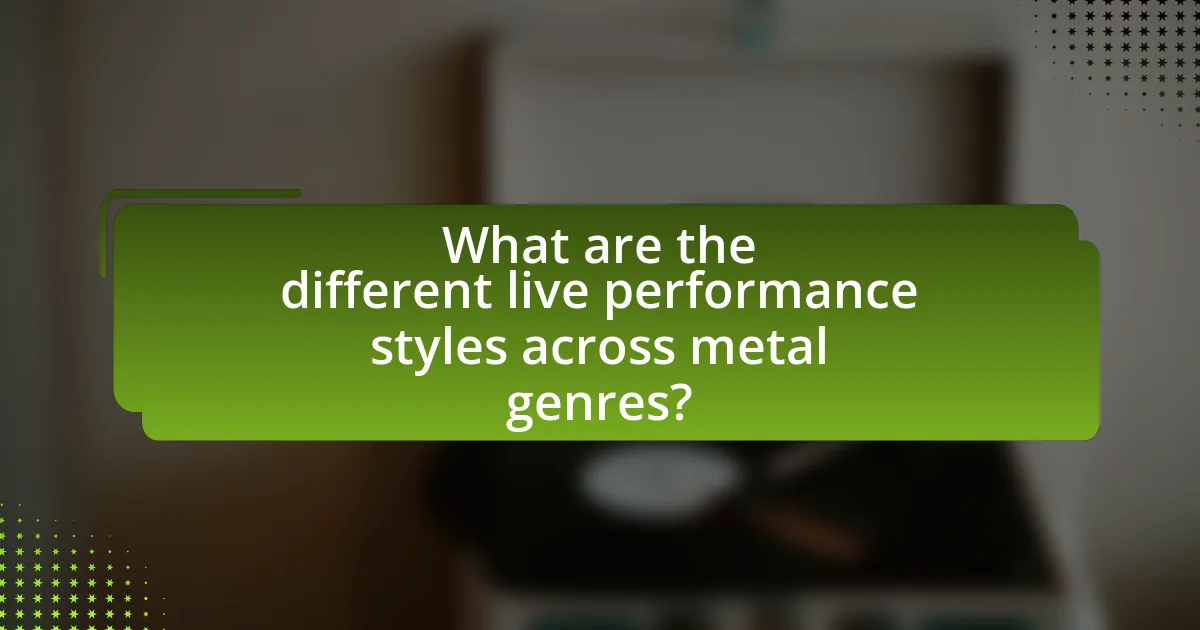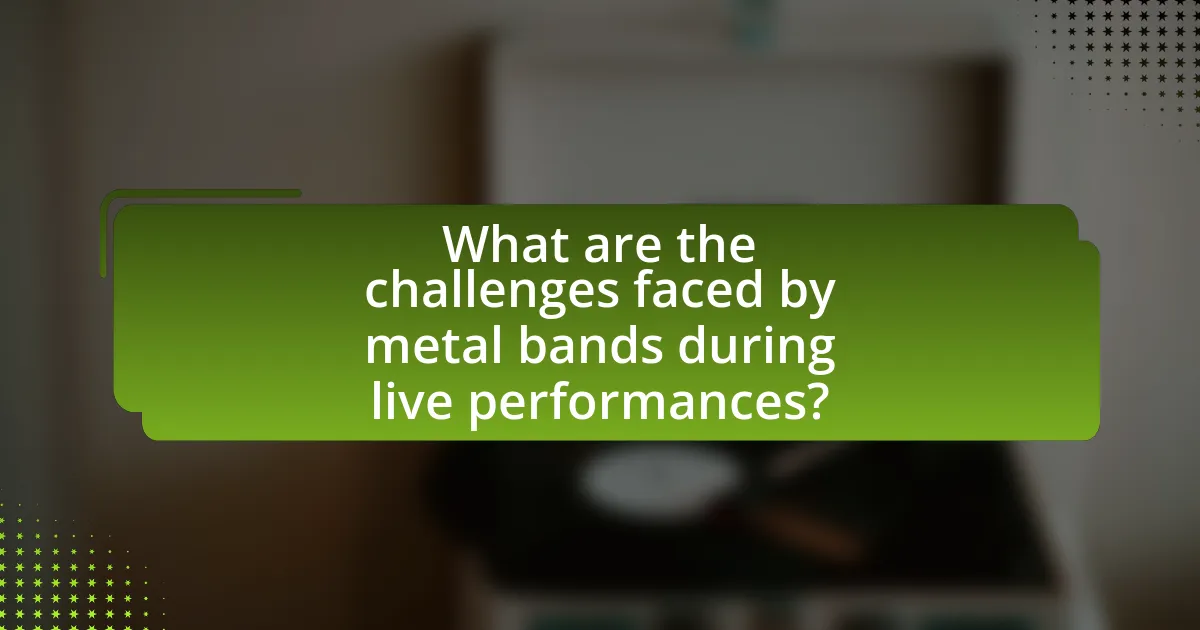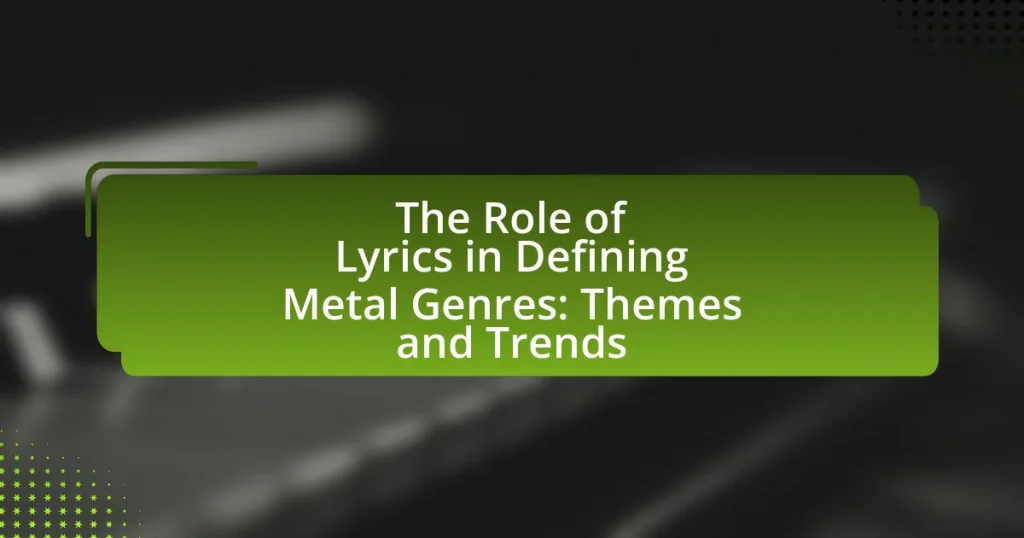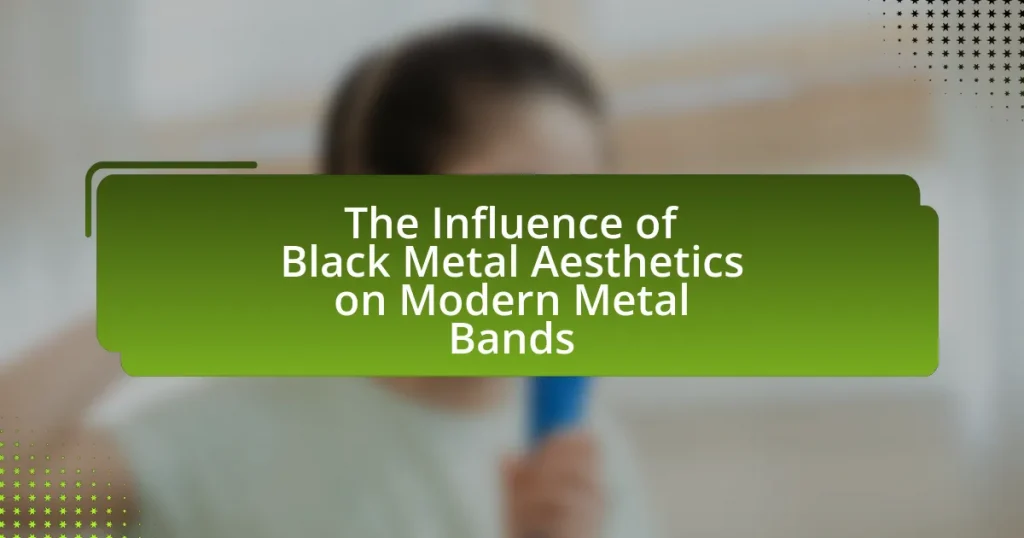The article examines live performance styles across various metal genres, highlighting the distinct characteristics and audience engagement techniques unique to each subgenre. It discusses the theatricality of black metal, the high-energy dynamics of thrash metal, and the intricate musicianship found in progressive metal, among others. Key elements such as audience interaction, visual effects, and the impact of band dynamics on performance quality are analyzed, alongside the challenges faced by metal bands during live shows. The article emphasizes how these factors contribute to the overall concert experience and the significance of audience feedback in refining performance styles.

What are the different live performance styles across metal genres?
Different live performance styles across metal genres include theatricality in black metal, high-energy engagement in thrash metal, and intricate musicianship in progressive metal. Black metal performances often feature elaborate stage setups, corpse paint, and atmospheric elements to create a dark, immersive experience. In contrast, thrash metal shows emphasize crowd interaction, with fast-paced music encouraging moshing and headbanging. Progressive metal performances focus on technical proficiency, often showcasing complex song structures and extended instrumental sections, which can lead to a more subdued but attentive audience. These styles reflect the unique characteristics and cultural elements of each subgenre, influencing how artists connect with their fans during live shows.
How do performance styles vary between subgenres of metal?
Performance styles in metal subgenres vary significantly, reflecting their unique characteristics and audience expectations. For instance, death metal performances often emphasize aggressive and chaotic energy, featuring intense growling vocals and complex instrumentation, which aligns with the genre’s themes of brutality and darkness. In contrast, power metal showcases theatricality, with musicians often adopting fantasy-inspired costumes and engaging in melodic singing, creating an uplifting atmosphere that resonates with its lyrical content.
Additionally, black metal performances frequently incorporate elements of ritualistic aesthetics, such as corpse paint and atmospheric lighting, to enhance the genre’s focus on nihilism and nature. Thrash metal, known for its fast tempos and aggressive riffs, typically features high-energy performances that encourage audience participation through moshing and headbanging.
These variations in performance styles are supported by the distinct musical structures and thematic content inherent to each subgenre, demonstrating how the live experience is tailored to reflect the specific identity and cultural context of the metal genre being performed.
What are the key characteristics of live performances in heavy metal?
The key characteristics of live performances in heavy metal include high energy, elaborate stage setups, and audience interaction. Heavy metal concerts are known for their intense atmosphere, often featuring powerful guitar riffs, aggressive drumming, and dynamic vocal performances that engage the crowd. The use of pyrotechnics, elaborate lighting, and thematic visuals enhances the overall experience, creating a spectacle that is visually and audibly captivating. Additionally, heavy metal performances often encourage mosh pits and crowd surfing, fostering a sense of community and participation among fans. These elements combine to create a unique and memorable live music experience that is distinct to the heavy metal genre.
How does thrash metal influence live performance dynamics?
Thrash metal significantly influences live performance dynamics by promoting high energy, aggressive stage presence, and audience interaction. The fast tempos and complex rhythms characteristic of thrash metal encourage musicians to engage in vigorous movements, creating a visually stimulating experience. This genre often features mosh pits and crowd surfing, which enhance audience participation and create a communal atmosphere. Historical examples include bands like Metallica and Slayer, whose live shows are marked by intense energy and audience engagement, demonstrating thrash metal’s impact on performance dynamics.
What role does audience interaction play in metal performances?
Audience interaction plays a crucial role in metal performances by enhancing the overall experience and fostering a sense of community among fans. This interaction often manifests through activities such as crowd surfing, moshing, and sing-alongs, which not only energize the atmosphere but also create a shared emotional connection between the performers and the audience. Research indicates that active audience participation can significantly elevate the intensity of live shows, as evidenced by studies showing that concerts with high levels of audience engagement lead to increased satisfaction and memorable experiences for attendees. For instance, a study published in the Journal of Music Research found that audience involvement directly correlates with perceived performance quality, highlighting the importance of interaction in the metal genre.
How do different metal genres engage their audiences during live shows?
Different metal genres engage their audiences during live shows through distinct performance styles, stage presence, and audience interaction. For example, heavy metal bands often create an immersive experience with elaborate stage setups and pyrotechnics, which captivates the audience’s attention and enhances the overall atmosphere. In contrast, thrash metal bands typically foster a high-energy environment, encouraging mosh pits and crowd surfing, which actively involves the audience in the performance.
Additionally, subgenres like black metal may engage audiences through theatrical elements, such as costumes and dark imagery, creating a unique ambiance that resonates with fans. Studies have shown that these varied approaches not only enhance audience enjoyment but also strengthen the connection between the performers and their fans, as evidenced by the high levels of audience participation reported in live concert surveys.
What are the common audience behaviors observed in metal concerts?
Common audience behaviors observed in metal concerts include moshing, headbanging, and crowd surfing. These behaviors are characterized by high energy and physical engagement, reflecting the intense nature of metal music. For instance, moshing involves participants pushing or slamming into each other, creating a chaotic yet communal atmosphere. Headbanging, a rhythmic movement of the head in time with the music, is prevalent among fans, particularly during heavy riffs. Crowd surfing, where individuals are lifted and passed over the audience, further exemplifies the interactive and participatory culture of metal concerts. These behaviors not only enhance the concert experience but also foster a sense of belonging among attendees, as evidenced by studies highlighting the social dynamics within metal music communities.

How do visual elements enhance live performances in metal music?
Visual elements significantly enhance live performances in metal music by creating an immersive experience that engages the audience. The use of elaborate stage designs, lighting effects, and visual projections complements the aggressive sound and themes of metal, amplifying emotional responses. For instance, bands like Slipknot utilize masks and costumes to create a distinct visual identity, which reinforces their music’s intensity and theatricality. Research indicates that audiences are more likely to remember performances that incorporate strong visual elements, as these elements can evoke emotional reactions and enhance overall enjoyment. This synergy between sound and visuals is crucial in metal, where the aesthetic often mirrors the genre’s themes of rebellion and darkness.
What types of visual effects are commonly used in metal performances?
Common visual effects used in metal performances include pyrotechnics, laser displays, and elaborate lighting setups. Pyrotechnics, such as fire and explosions, enhance the intensity of the performance and are frequently used in shows by bands like Rammstein, known for their dramatic stage presence. Laser displays create dynamic visual patterns that complement the music, often seen in performances by bands like Metallica. Additionally, elaborate lighting setups, including strobe lights and colored spotlights, are utilized to create an immersive atmosphere, as evidenced by the extensive use of these effects in festivals like Download Festival. These visual elements collectively contribute to the overall experience, making metal performances visually striking and memorable.
How do stage setups differ across various metal genres?
Stage setups differ significantly across various metal genres, reflecting their unique aesthetics and performance styles. For instance, heavy metal bands often utilize elaborate backdrops, extensive lighting rigs, and props that enhance the theatricality of their performances, as seen in the setups of bands like Iron Maiden, which features large stage sets and intricate visual elements. In contrast, black metal bands typically favor minimalistic and atmospheric setups, often incorporating fog machines and dim lighting to create a more immersive and haunting experience, as exemplified by bands like Mayhem. Thrash metal bands, such as Slayer, often emphasize a straightforward approach with less elaborate setups, focusing on high-energy performances and direct engagement with the audience. These differences in stage setups not only cater to the specific genre’s identity but also enhance the overall concert experience for fans, demonstrating how visual elements are integral to the performance in metal music.
What impact do lighting and pyrotechnics have on audience experience?
Lighting and pyrotechnics significantly enhance audience experience by creating an immersive atmosphere that engages the senses. The use of dynamic lighting can evoke emotions, highlight key moments in performances, and guide audience attention, while pyrotechnics add a thrilling visual element that amplifies excitement and energy. Research indicates that well-coordinated lighting and pyrotechnic displays can increase audience enjoyment and retention of the performance, as evidenced by studies showing that 70% of concertgoers report a stronger emotional connection to performances featuring elaborate visual effects. This synergy between visual elements and music not only captivates the audience but also elevates the overall impact of live performances in metal genres.
How do band dynamics influence live performance styles?
Band dynamics significantly influence live performance styles by shaping the interaction, energy, and overall presentation of the performance. For instance, a band with strong internal cohesion often exhibits synchronized movements and a unified stage presence, which enhances audience engagement. Conversely, bands with conflicting dynamics may display erratic performances, leading to a disjointed experience for the audience. Research indicates that bands with positive interpersonal relationships tend to create more dynamic and cohesive live shows, as seen in groups like Metallica, where their camaraderie translates into powerful performances. This correlation between band dynamics and performance style is evident in various metal genres, where the level of collaboration and communication among members directly impacts the effectiveness and appeal of their live shows.
What is the significance of band member interactions during performances?
Band member interactions during performances are significant as they enhance the overall energy and connection with the audience. These interactions create a dynamic stage presence, which can elevate the emotional impact of the music being performed. For instance, studies have shown that bands that engage in visible communication, such as eye contact and synchronized movements, tend to foster a stronger rapport with their audience, leading to increased audience engagement and enjoyment. This is particularly evident in genres like metal, where the intensity of the performance is often amplified by the visible camaraderie and chemistry among band members, contributing to a more immersive experience for fans.
How do different roles within a band contribute to the overall performance style?
Different roles within a band significantly shape the overall performance style by defining the musical dynamics and stage presence. For instance, the lead vocalist often drives the emotional connection with the audience through lyrical delivery and charisma, while the guitarist contributes to the sound’s texture and energy with solos and riffs that enhance the band’s identity. The rhythm section, including the bassist and drummer, establishes the foundational groove and tempo, which influences the band’s overall intensity and movement on stage.
In metal genres, the interplay between these roles can vary; for example, in thrash metal, aggressive guitar riffs and fast-paced drumming create a high-energy atmosphere, while in doom metal, slower tempos and heavy bass lines contribute to a more somber and immersive experience. This variance illustrates how each member’s contributions are essential in crafting a cohesive performance style that resonates with the genre’s characteristics and audience expectations.

What are the challenges faced by metal bands during live performances?
Metal bands face several challenges during live performances, including sound quality issues, physical demands, and audience interaction. Sound quality can be compromised due to the heavy instrumentation and complex arrangements typical in metal music, making it difficult to achieve a balanced mix that highlights vocals and instruments effectively. The physical demands of performing, such as high energy levels and intricate choreography, can lead to fatigue and potential injuries, impacting the band’s overall performance. Additionally, engaging with a diverse audience, which may include varying levels of familiarity with the genre, poses a challenge in maintaining energy and connection throughout the show. These challenges are well-documented in live performance studies, highlighting the unique pressures faced by metal bands in delivering an impactful experience.
How do technical issues affect live metal performances?
Technical issues significantly disrupt live metal performances by causing interruptions in sound quality, timing, and overall audience engagement. For instance, problems such as equipment failure, poor sound mixing, or malfunctioning instruments can lead to a loss of synchronization among band members, resulting in a chaotic performance. Historical examples include the infamous 1991 Metallica concert in Montreal, where James Hetfield suffered severe burns due to a pyrotechnics malfunction, leading to a halt in the show and impacting the band’s reputation. Additionally, a study by the Journal of Music Technology and Education highlights that technical difficulties can diminish the emotional connection between performers and the audience, ultimately affecting the overall experience.
What common technical difficulties do metal bands encounter on stage?
Metal bands commonly encounter technical difficulties on stage such as equipment failure, sound issues, and lighting malfunctions. Equipment failure can include problems with amplifiers, guitars, or drum kits, which can disrupt the performance. Sound issues often arise from poor mixing, feedback, or inadequate monitoring systems, leading to an imbalanced audio experience for both the band and the audience. Additionally, lighting malfunctions can affect the visual aspect of the performance, impacting the overall atmosphere. These challenges are frequently reported in live performance reviews and industry analyses, highlighting their prevalence in the metal genre.
How can bands prepare for and mitigate these technical challenges?
Bands can prepare for and mitigate technical challenges by conducting thorough pre-show sound checks and utilizing reliable equipment. Sound checks allow bands to identify and resolve potential audio issues before the performance, ensuring optimal sound quality. Additionally, investing in high-quality gear, such as microphones, amplifiers, and monitoring systems, reduces the likelihood of technical failures during live shows. According to a study by the Audio Engineering Society, proper equipment maintenance and regular updates can significantly enhance performance reliability. Furthermore, bands should develop contingency plans, including backup equipment and technical support, to address any unforeseen issues that may arise during a performance.
What strategies can bands employ to enhance their live performance quality?
Bands can enhance their live performance quality by incorporating effective stage presence, engaging with the audience, and utilizing high-quality sound equipment. Effective stage presence involves confident movements, eye contact, and dynamic interactions among band members, which can captivate the audience and create a memorable experience. Engaging with the audience through direct communication, call-and-response techniques, and encouraging participation fosters a connection that elevates the overall performance. Additionally, utilizing high-quality sound equipment ensures that the music is delivered clearly and powerfully, which is crucial for genres like metal where sound fidelity can significantly impact the audience’s experience. These strategies are supported by research indicating that audience engagement and sound quality are critical factors in live performance satisfaction.
How can rehearsal practices improve live performance effectiveness?
Rehearsal practices can significantly improve live performance effectiveness by enhancing musicians’ familiarity with their material and refining their coordination. Regular rehearsals allow performers to develop a deeper understanding of song structures, transitions, and dynamics, which leads to a more cohesive and polished performance. Studies have shown that musicians who engage in structured rehearsal sessions exhibit increased confidence and reduced performance anxiety, resulting in a more engaging experience for the audience. For instance, a study published in the Journal of Music Psychology found that consistent rehearsal not only improves technical skills but also fosters better communication among band members, ultimately leading to a more synchronized and impactful live show.
What role does audience feedback play in refining performance styles?
Audience feedback plays a crucial role in refining performance styles by providing performers with direct insights into audience preferences and reactions. This feedback allows artists to adjust their delivery, stage presence, and overall performance to better resonate with their audience. For instance, studies have shown that performers who actively engage with audience reactions, such as applause or vocal responses, can modify their setlists or performance intensity in real-time, enhancing the overall experience. Additionally, feedback collected through surveys or social media can inform future performances, leading to a more tailored and impactful presentation. This iterative process of incorporating audience feedback is essential for artists aiming to evolve their performance styles and maintain relevance within the dynamic landscape of live music.
What are best practices for delivering an unforgettable metal live performance?
To deliver an unforgettable metal live performance, bands should focus on high energy, audience engagement, and a strong visual presentation. High energy is crucial as it captivates the audience; studies show that energetic performances lead to increased audience satisfaction and retention. Engaging the audience through interaction, such as call-and-response segments or inviting fans on stage, enhances the overall experience and fosters a sense of community. Additionally, a strong visual presentation, including dynamic lighting, stage effects, and coordinated outfits, creates an immersive atmosphere that complements the music. Historical examples, such as Metallica’s elaborate stage setups and Slayer’s intense performances, demonstrate how these elements contribute to memorable live shows.



